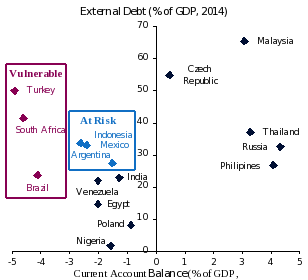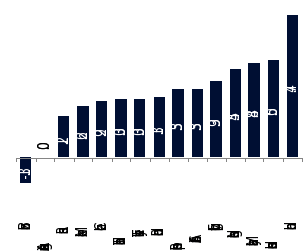Last week we posed the question whether the Fed should raise interest rates and concluded that the current levels of US unemployment and inflation warrant at least one, if not two hikes this year (Should the Fed Raise Interest Rates in 2015?, 28 June 2015). We now ask, which emerging market (EM) countries are most vulnerable to higher US interest rates. Taking stock of the 1997 Asian Financial Crisis and the 2013 taper tantrum, we consider three metrics: the current account balance, external debt and real GDP growth. Out of our selection of 16 of the largest EMs, we find that Turkey, South Africa and Brazil are the most vulnerable while Indonesia, Mexico and Argentina are also at risk.
The main reason for EM vulnerability is a heavy reliance on capital inflows. As interest rates in the US rise, there is a risk that capital could flow out of EMs, into the US to take advantage of higher relative yields. This is what drove the EM capital flight shock in mid-2013—the “taper tantrum”—when the Federal Reserve (Fed) announced that it would begin cutting back its quantitative easing programme, leading to a sharp rise in US and global bond yields. The EMs that are most vulnerable to this kind of shock are those that are most dependent on capital inflows. A key metric in assessing vulnerability is, therefore, the current account balance—a country with a large deficit is reliant on capital inflows to finance the deficit. The countries expected to have the largest current account deficits in 2015 are Turkey (4.9% of GDP), South Africa (4.6%) and Brazil (4.1%). The other countries that we consider to be at risk all have current account deficits in the range of 2.6%-1.3% of GDP.
Vulnerability of Selected EMs to Higher US Interest Rates

A second measure of vulnerability is external debt, which is usually denominated in US dollars. As US interest rates rise and capital flows back to the US, the dollar is likely to strengthen. This increases the value of US dollar debt and also increases the burden of servicing this debt as payments rise in local currency terms. Therefore, countries with high levels of external debt will find it more difficult to meet their obligations and dollar debt will become an increasing drag on the economy. High levels of external debt will increase investor risk perceptions of a country, leading to a higher risk of a sudden stop in capital flows.The average level of external debt among our selected EMs is 31% of GDP. Once again, Turkey and South Africa stand out with relatively high levels of external debt (50% and 41% of GDP, respectively). Indonesia (34%) and Mexico (33%) also have relatively high levels of external debt.
A final measure of vulnerability is real GDP growth. High growth will raise predicted returns for investors, increasing the appeal of the country. Conversely, low growth will encourage investors to withdraw capital and increase the risk of a sudden stop in capital flows. The Brazilian economy is currently challenged by GDP growth, which is expected to contract by 1.3% in 2015, due to low commodity prices and rising central bank interest rates to combat rampant inflation. For this reason, and given Brazil’s high current account deficit, we consider it to be as vulnerable as Turkey and South Africa. Growth in Turkey is expected to be around 3.0% in 2015, fairly unremarkable and insufficient to offset the country’s external risks.
The countries we consider as at risk have relatively diverse real GDP growth rates. Growth in Argentina is expected to be zero in 2015 as the country struggles to recover from its legacy debt overhang. This lack of growth, combined with a current account deficit (1.5% of GDP) and moderate external debt (27% of GDP), leaves the country exposed if US interest rates rise. Indonesia is expected to grow faster at 5.0%, which should help attract some capital despite the external risks. Mexico has similar external vulnerabilities to Indonesia, but lower GDP growth (2.6% in 2015).
Real GDP Growth in Selected EMs (%, 2015)

In conclusion, a Fed rate hike this year appears likely, with a 50:50 chance of a first rate hike in September. Higher US interest rates will probably lead to considerable volatility in global financial markets and elevated EM risk. Turkey, South Africa and Brazil seem the most exposed, followed by Indonesia, Mexico and Argentina.
